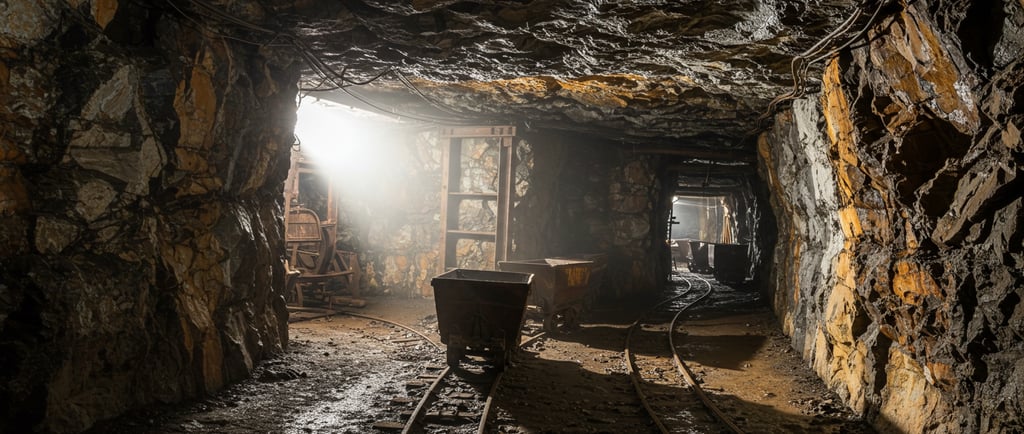The Ouro Preto Mines of Minas Gerais: Brazil's Gemstone Treasure Trove
Explore Brazil's legendary Ouro Preto mines in Minas Gerais—home to Imperial Topaz, White Topaz, and rare gemstones. Discover the Capão do Lana Mine's history, location, and why it's a global gemstone hotspot!
MINES
Introduction: A Legacy of Gold and Gems
Nestled in the heart of Brazil's mineral-rich state of Minas Gerais, the historic mining district of Ouro Preto is a legendary source of some of the world's most exquisite gemstones. Famous for its gold rush history and now a UNESCO World Heritage Site, Ouro Preto is a premier location for mining Topaz, Tourmaline, Aquamarine, and Quartz. Among its many mines, the Capão do Lana Mine stands out as a prolific producer of high-quality White Topaz and Imperial Topaz.
This blog post explores Ouro Preto's mines' geography, history, and gemological significance, focusing on the Capão do Lana Mine—one of Brazil's most important gemstone sources.
Where is the Ouro Preto Mining District?
Geographical Location
Ouro Preto (meaning "Black Gold") is located in Minas Gerais, southeastern Brazil, approximately:
Distance from Belo Horizonte (state capital): ~100 km (62 miles) southeast
GPS Coordinates: 20°23'08"S, 43°30'29"W
Elevation: ~1,100 meters (3,600 ft) above sea level
The region is part of the Espinhaço Mountain Range, a geological hotspot for pegmatite veins that yield world-class gemstones.
Map Location:
State: Minas Gerais
Nearest Major City: Belo Horizonte
Latitude 20°23'08"S
Longitude 43°30'29"W
Historical Significance: From Gold Rush to Gemstone Hub
The Gold Boom (18th Century)
Ouro Preto was the epicentre of Brazil's 18th-century gold rush, attracting prospectors from around the world. The wealth extracted from its mines funded Portugal's empire and led to the city's stunning Baroque architecture, now preserved as a UNESCO World Heritage Site.
Transition to Gemstone Mining
After gold reserves diminished, miners turned to coloured gemstones, discovering rich deposits of:
Topaz (White, Imperial, and Blue varieties)
Tourmaline (including rare Paraíba-like specimens)
Aquamarine & Quartz
Today, Ouro Preto remains one of Brazil's most important gem-producing regions.
Capão do Lana Mine: A Premier Source of Topaz
Location & Geology
The Capão do Lana Mine is one of the most productive mines in Ouro Preto, specialising in:
Imperial Topaz (a rare, golden-pink variety)
White Topaz (prized for its diamond-like brilliance)
The mine extracts gemstones from hydrothermal veins within pegmatite formations, where minerals crystallise under high pressure.
Mining Techniques
Open-Pit Mining – Removing surface layers to access gem-bearing rock.
Underground Tunneling – Following pegmatite veins deep into the mountains.
Manual Sorting – Miners carefully extract and hand-select gem-quality rough.
Why is Capão do Lana Special?
Produces some of the finest Imperial Topaz in the world.
Supplies high-clarity White Topaz for jewellery markets.
Operates with semi-mechanised methods, balancing productivity and sustainability.
Gemstones from Ouro Preto's Mines
1. Imperial Topaz
Colour: Golden-orange to pinkish-red
Rarity: Among the most valuable Topaz varieties
Primary Source: Capão do Lana Mine
2. White Topaz
Appearance: Colorless, diamond-like brilliance
Uses: Affordable alternative to diamonds in jewellery
3. Other Notable Gemstones
Tourmaline (multicolor and neon-blue varieties)
Aquamarine (pale blue to deep ocean blue)
Smoky Quartz & Amethyst
Visiting Ouro Preto: A Gem Hunter's Paradise
Tourist Attractions
Museu das Pedras (Gemstone Museum) – Displays rare regional minerals.
Old Gold Mines – Now open for historical tours.
Baroque Churches – Intricate gold-covered altars from the mining boom.
Buying Gemstones in Ouro Preto
Local Lapidaries offer cut and polished stones.
Gem Fairs (Feira de Pedras) feature miners selling rough specimens.
Conclusion: A Living Legacy of Gemstones
Ouro Preto's mines, particularly the Capão do Lana Mine, continue to supply the world with exceptional Topaz and other gemstones. Whether you're a gem enthusiast, a jewellery designer, or a history buff, this region offers a fascinating glimpse into Brazil's mineral wealth.


